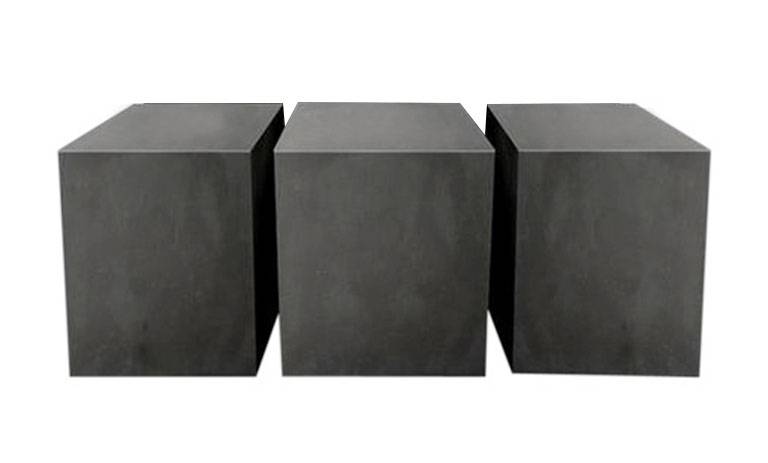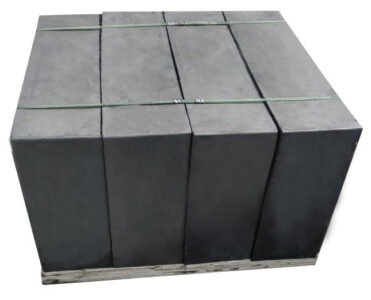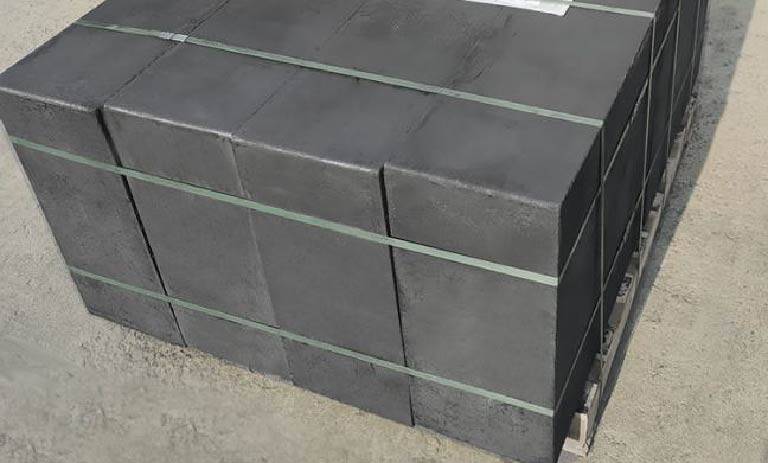Step-by-Step: Exploring the Manufacturing Process of Isostatic Graphite Materials

In terms of applications, isostatically pressed graphite finds widespread use in industries such as metallurgy, chemistry, electrical engineering, aerospace, and atomic energy due to its exceptional properties. For instance, in the metallurgical sector, isostatic pressing graphite is employed in the production of high-purity graphite crucibles for melting various metals and alloys. In the chemical industry, it is utilized in manufacturing chemical reactors, heat exchangers, and more. In aerospace, isostatic graphite is crucial for crafting high-temperature components like rocket nozzles and aero engines. In the atomic energy industry, it is applied in the production of control rods for nuclear reactors.
Furthermore, with ongoing advancements in science and technology, the application scope of isostatic graphite continues to broaden. For example, in recent years, its use in the manufacture of battery anode materials for electric vehicles has demonstrated excellent performance. Looking ahead, as new energy sources and materials continue to develop, the prospects for isostatic graphite applications are expected to expand even further.
Production Process of Isostatic Pressed Graphite
The production process for isostatically pressed graphite is shown in Figure 1. Unlike graphite electrodes, isostatically pressed graphite requires the use of structurally isotropic feedstocks with increased powder fineness. With the use of cold isostatic molding technology, the roasting cycle becomes very long and several impregnation-roasting cycles are required to achieve the target density. In addition, the graphitizing cycle in this process is also longer than for normal graphite. An alternative method of producing isostatically pressed graphite is to use intermediate-phase carbon microspheres as feedstock, which are oxidatively stabilized at higher temperatures before being isostatically pressed into shape, roasted, and graphitized. This method is not covered in this paper.

Step 1: Raw Materials
The raw materials used in the production of isostatic graphite include aggregate and a binder. Typically, petroleum coke and asphalt coke are used as aggregate, with some cases utilizing ground asphalt coke, such as the United States POCO’s AXF series of isostatically pressed graphite, which is produced using ground asphalt coke, specifically Gilsonite coke.
To tailor the product’s performance for different applications, additives such as carbon black and artificial graphite are sometimes employed. Generally, petroleum coke and bituminous coke undergo calcination at 1200-1400°C to eliminate moisture and volatiles before use.
In order to enhance the mechanical properties and structural densities of the products, some manufacturers use raw coke directly as a material for isostatic graphite production. Raw coke is characterized by the presence of volatiles, self-sintering, and simultaneous expansion and contraction with the binder coke. The binder typically involves the use of coal pitch, with a softening point ranging from 50°C to 250°C, depending on the equipment conditions and process requirements of each enterprise.
The performance of isostatic graphite is significantly influenced by the choice of raw materials, making the selection a crucial step in producing the desired end product. Strict checks on the characteristics and uniformity of the raw materials must be conducted before processing.
Step 2: Grinding
The aggregate size of isostatic graphite is typically required to be below 20μm. Currently, the finest isostatic graphite has a maximum particle diameter of 1μm, indicating its very fine nature.
To grind the aggregate coke into such a fine powder, an ultra-fine pulverizer is necessary. Vertical roller mills are employed to grind powders with an average particle size of 10-20μm, while air mills are used for powders with an average particle size of less than 10μm.
Step 3: Kneading
Proportionally introduce the milled powder and coal asphalt binder into the heated kneading machine for thorough kneading. This process ensures that the surface of the powdered coke particles uniformly adheres to a layer of asphalt. After kneading, the paste is removed and allowed to cool.
In comparison to the production of graphite electrodes, the production of isostatic graphite kneading requires a higher amount of bitumen, higher temperature, and longer duration.
Step 4: Second Grinding
The paste, post-crushing, grinding, and sieving, transforms into particles ranging from dozens to hundreds of microns in size after mixing. This mixture, referred to as powder, serves as a raw material for pressing. The equipment commonly used for secondary grinding is either a vertical roller mill or a ball mill.
Step 5: Molding
Unlike normal extrusion and molding processes, isostatic graphite is molded using cold isostatic pressing technology (Figure 2). The raw material pressed powder is filled into the rubber mold. Through high-frequency electromagnetic vibration, the pressed powder becomes dense, sealed, and vacuumed, discharging the air between the powder particles. The mold is then placed into a high-pressure container with a liquid medium such as water or oil, pressurized to 100-200 MPa, resulting in cylindrical or rectangular products.
Following Pascal’s principle, pressure is applied to the rubber mold through a liquid medium like water, ensuring equal pressure in all directions. This causes the pressed powder particles to compress in an irregular arrangement, making isostatically pressed graphite isotropic from an overall perspective, even though graphite possesses anisotropic crystallographic properties. The formed products include not only cylindrical and rectangular shapes but also cylindrical and crucible shapes.
Isostatic forming machines are primarily used in the powder metallurgy industry. Due to the needs of high-end industries such as aerospace, nuclear technology, cemented carbide, and high-pressure electromagnetics, isostatic pressure technology is advancing rapidly. The technology can now manufacture cold isostatic presses with the ability to achieve an inner diameter of the working cylinder of 3000 mm, height of 5000 mm, and the highest working pressure of 600 MPa. Presently, the largest specification of a cold isostatic press used for producing isostatic graphite in the carbon industry is Φ2150mm×4700 mm, with the highest working pressure of 180 MPa.
Step 6: Roasting
During the roasting process, a complex chemical reaction occurs between the aggregate and the binder. The binder decomposes, releasing a significant amount of volatiles, while simultaneously undergoing a condensation reaction. In the low-temperature preheating stage, the raw product expands due to heat. In the subsequent warming process, the volume shrinks due to the condensation reaction.
The larger the volume of the raw product, the more challenging the release of volatile matter. The surface and interior of the raw product are prone to temperature differences, thermal expansion, contraction, and other phenomena, which may lead to cracks in the raw product.
Due to its fine structure, the roasting process for isostatic graphite requires particular slowness, and the temperature inside the furnace should be very uniform. Especially in the rapid discharge stage of asphalt volatile components, the heating process should be cautious. The rate of warming should not exceed 1 ℃ / h, and the temperature difference inside the furnace should be less than 20 ℃. This process typically takes about 1 to 2 months.
Step 7: Impregnation
During the roasting process, the volatile components of coal pitch are discharged, leaving fine pores in the products, almost all of which are open pores.
To improve bulk density, mechanical strength, electrical conductivity, thermal conductivity, and chemical resistance, a pressure impregnation method is employed. This involves impregnating the product with melted coal asphalt through the open pores.
The products are preheated first, then vacuum degassed in the impregnation tank, and finally, melted coal asphalt is added to the tank. The impregnant asphalt is pressurized into the internal products. Usually, isostatic graphite undergoes several impregnation-roasting cycles.
Step 8: Graphitizing
The roasted products are heated to about 3,000 ℃, facilitating the orderly arrangement of carbon atom lattices and completing the transformation from carbon to graphite, a process known as graphitization.
Graphitization methods include the Acheson method, endothermic string method, high-frequency induction method, and others. In the Acheson method, the products typically take about 1 to 1.5 months to come out of the furnace. Each furnace can handle several to tens of tonnes of baked products.
After graphitizing, the bulk density, electrical conductivity, thermal conductivity, corrosion resistance, and machinability of the products are significantly improved. However, graphitizing reduces the flexural strength of the products.
Step 9: Check
After graphitizing, it is essential to check the density, hardness, strength, resistivity, ash, and other indicators of the products to determine whether they meet the required specifications.
Step 10: Purification
For isostatic graphite used in semiconductors, monocrystalline silicon, atomic energy, and other high-purity fields, chemical removal of impurities is necessary before use.
The usual practice involves heating graphitized products in halogen gas to about 2,000 ℃, halogenating impurities into low-boiling halides, and then volatilizing them. Almost all impurity elements in graphitized products can be halogenated with chlorine for removal. However, boron is an exception and can only be fluorinated away. The halogen gases used for purification are chlorine, fluorine, or halogenated hydrocarbons that can decompose at high temperatures to produce these gases, such as carbon tetrachloride (CCl4) or dichlorodifluoromethane (CCl2F2).
This purification method capitalizes on the fact that graphite does not react with halogens at high temperatures and its unique porous structure.
Graphite Materials have become an essential and key material in today’s industrial production, especially in the solar, LED, semiconductor, and nuclear industries. The demand for graphite is increasing dramatically, and the quality requirements are becoming higher and higher.
Applications
Isostatic graphite blocks are a versatile, high-performance material used in a wide range of applications. Its unique physical and chemical properties make it an indispensable material for many industrial applications.
Firstly, isostatic graphite plays an important role in the semiconductor industry, being used in the manufacture of heaters for direct-draw monocrystalline silicon hot fields and polysilicon ingot casting furnaces. These heaters are essential for heating silicon materials in semiconductor production, ensuring the efficiency and quality of the production process.
Isostatic graphite is also widely used in the atomic energy industry. It is used in the manufacture of heaters for nuclear fission reactors, particularly high-temperature gas-cooled reactors. This reflects the material’s excellent stability and heat resistance in high-temperature and high-pressure environments.
In addition, isostatic graphite plays a key role in the processing of metal molds and other processes. In the continuous casting of non-ferrous metals, it is used as a graphite crystalliser, helping to ensure that the continuous casting process runs smoothly.
More impressively, isostatic graphite is also widely used in the manufacture of sintering molds for diamond tools and cemented carbides. In addition, it plays an indispensable role in fiber optic wire drawing machines, vacuum heat treatment furnaces, precision graphite heat exchangers, mechanical sealing components, piston rings, bearings, rocket nozzles, and more. These applications demonstrate the excellent performance and versatility of isostatic graphite in harsh environments such as high temperature, high pressure, and corrosion. With the continuous development of science and technology, the application prospects of isostatic graphite will continue to expand.




